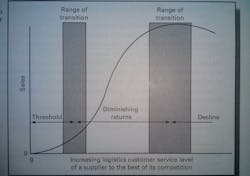"What does the two-point method mean in logistics?"
What does the two-point method mean in logistics?
EXPERT ANSWER:I admit I’ve not heard of the “two point” method. I googled the term and did get a hit on the material below in red. I’ll briefly comment on it but first let me preface my comments with the following. I’ve never heard this term mentioned in my 20+ years in private industry practice and hadn’t run across it in academia either. So before responding, I just checked the indexes of three premier, highly utilized supply chain and logistics textbooks. Additionally I checked the CSCMP’s absolutely huge glossary of terms (122 pages). Your question piqued my interest and I wondered if I had missed something. I can tell you that none of these three premier textbooks nor the CSCMP glossary noted the two-point method. That is not a criticism, just a comment.
That said, from the material I googled and cut and pasted below (http://piropirologistics.blogspot.com/2012/09/modelling-sales-service-relationship.html) we can see that wherever this concept is used – it involves trade-offs between different levels of customer service and different levels of sales (and I presume) profitability. Customer service level is not defined. That said, one could use one’s own definition to explore this principal.
What this reminds me of, and what is very standard supply chain/logistics knowledge is in the area of inventory management. For example, theoretically, a firm determining the “optimal level” of inventory investment to make in finished goods (say for a product at a distribution facility or retail store) is the level (inflexion point) where the “incremental investment” in additional finished goods inventory to facilitate higher sales (i.e., lower stock outs) is equal to the profitability of the “incremental sales” that a higher level of inventory investment would facilitate. The theory is that at this point, the firm has the perfect balance between its inventory investment costs and its profitability from sales revenue. If the firm invests more in inventory, the incremental inventory investment costs will outweigh the incremental gain in profitability. Conversely, if the firm invests less in inventory, the savings in inventory investment costs will be outweighed by the loss in sales (and profits) resulting from the decreased inventory levels.
In practice, this point is very hard to estimate and there are many other factors that complicate this decision. Nevertheless, it is an important theory that a logistics manager should have in the back of his/her mind in order to make a good decision on the optimal level of inventory investment.
This concept (two point method) also seems to have similarities or parallels to the concept of the “efficient production frontier” in economics. However I will simply note this and not elaborate.
Modelling the Sales-Service Relationship Two Points Method (Frame 1)
- Involves establishing two points on the diminishing return portion of the sales-service relationship through which a straight line can be drawn.
- Involves setting logistics customer service at high level for a particular product and observed the sales that can be drawn.
- Then the level is reduced to low level and sales are again noted.
Modelling the Sales-Service Relationship Two Points Method (Frame 2)
- Involves establishing two points on the diminishing return portion of the sales-service relationship through which a straight line can be drawn.
- Involves setting logistics customer service at high level for a particular product and observed the sales that can be drawn.
- Then the level is reduced to low level and sales are again noted.


